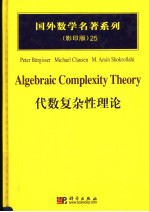图书介绍
代数复杂性理论PDF|Epub|txt|kindle电子书版本网盘下载

- (瑞士)比尔吉斯尔等著 著
- 出版社: 北京:科学出版社
- ISBN:7030182995
- 出版时间:2007
- 标注页数:618页
- 文件大小:103MB
- 文件页数:40204592页
- 主题词:代数-复杂性理论-英文
PDF下载
下载说明
代数复杂性理论PDF格式电子书版下载
下载的文件为RAR压缩包。需要使用解压软件进行解压得到PDF格式图书。建议使用BT下载工具Free Download Manager进行下载,简称FDM(免费,没有广告,支持多平台)。本站资源全部打包为BT种子。所以需要使用专业的BT下载软件进行下载。如BitComet qBittorrent uTorrent等BT下载工具。迅雷目前由于本站不是热门资源。不推荐使用!后期资源热门了。安装了迅雷也可以迅雷进行下载!
(文件页数 要大于 标注页数,上中下等多册电子书除外)
注意:本站所有压缩包均有解压码: 点击下载压缩包解压工具
图书目录
Chapter 1. Introduction1
1.1 Exercises20
1.2 Open Problems23
1.3 Notes23
Part Ⅰ. Fundamental Algorithms27
Chapter 2. Efficient Polynomial Arithmetic27
2.1 Multiplication of Polynomials Ⅰ28
2.2 Multiplication of Polynomials Ⅱ34
2.3 Multiplication of Several Polynomials38
2.4 Multiplication and Inversion of Power Series44
2.5 Composition of Power Series47
2.6 Exercises53
2.7 Open Problems57
2.8 Notes58
Chapter 3. Efficient Algorithms with Branching61
3.1 Polynomial Greatest Common Divisors61
3.2 Local Analysis of the Knuth-Schonhage Algorithm71
3.3 Evaluation and Interpolation75
3.4 Fast Point Location in Arrangements of Hyperplanes79
3.5 Vapnik-Chervonenkis Dimension and Epsilon-Nets84
3.6 Exercises90
3.7 Open Problems97
3.8 Notes98
Part Ⅱ. Elementary Lower Bounds103
Chapter 4. Models of Computation103
4.1 Straight-Line Programs and Complexity103
4.2 Computation Sequences109
4.3 Autarky111
4.4 Computation Trees113
4.5 Computation Trees and Straight-line Programs118
4.6 Exercises121
4.7 Notes124
Chapter 5. Preconditioning and Transcendence Degree125
5.1 Preconditioning125
5.2 Transcendence Degree130
5.3 Extension to Linearly Disjoint Fields134
5.4 Exercises136
5.5 Open Problems142
5.6 Notes142
Chapter 6. The Substitution Method143
6.1 Discussion of Ideas144
6.2 Lower Bounds by the Degree of Linearization148
6.3 Continued Fractions,Quotients,and Composition151
6.4 Exercises157
6.5 Open Problems159
6.6 Notes159
Chapter 7. Differential Methods161
7.1 Complexity of Truncated Taylor Series161
7.2 Complexity of Partial Derivatives164
7.3 Exercises167
7.4 Open Problems168
7.5 Notes168
Part Ⅲ. High Degree171
Chapter 8. The Degree Bound171
8.1 A Field Theoretic Version of the Degree Bound171
8.2 Geometric Degree and a Bezout Inequality178
8.3 The Degree Bound182
8.4 Applications186
8.5 Estimates for the Degree192
8.6 The Case of a Finite Field195
8.7 Exercises198
8.8 Open Problems205
8.9 Notes205
Chapter 9.Specific Polynomials which Are Hard to Compute207
9.1 A Generic Computation207
9.2 Polynomials with Algebraic Coefficients211
9.3 Applications218
9.4 Polynomials with Rapidly Growing Integer Coefficients224
9.5 Extension to other Complexity Measures230
9.6 Exercises236
9.7 Open Problems243
9.8 Notes243
Chapter 10. Branching and Degree245
10.1 Computation Trees and the Degree Bound245
10.2 Complexity of the Euclidean Representation248
10.3 Degree Pattern of the Euclidean Representation253
10.4 Exercises260
10.5 Open Problems263
10.6 Notes264
Chapter 11. Branching and Connectivity265
11.1 Estimation of the Number of Connected Components265
11.2 Lower Bounds by the Number of Connected Components272
11.3 Knapsack and Applications to Computational Geometry275
11.4 Exercises278
11.5 Open Problems282
11.6 Notes283
Chapter 12. Additive Complexity287
12.1 Introduction287
12.2 Real Roots of Sparse Systems of Equations289
12.3 A Bound on the Additive Complexity296
12.4 Exercises298
12.5 Open Problems300
12.6 Notes301
Part Ⅳ. Low Degree305
Chapter 13. Linear Complexity305
13.1 The Linear Computational Model305
13.2 First Upper and Lower Bounds309
13.3 A Graph Theoretical Approach314
13.4 Lower Bounds via Graph Theoretical Methods318
13.5 Generalized Fourier Transforms326
13.6 Exercises345
13.7 Open Problems348
13.8 Notes348
Chapter 14. Multiplicative and Bilinear Complexity351
14.1 Multiplicative Complexity of Quadratic Maps351
14.2 The Tensorial Notation357
14.3 Restriction and Conciseness361
14.4 Other Characterizations of Rank365
14.5 Rank of the Polynomial Multiplication367
14.6 The Semiring T368
14.7 Exercises370
14.8 Open Problems373
14.9 Notes373
Chapter 15. Asymptotic Complexity of Matrix Multiplication375
15.1 The Exponent of Matrix Multiplication375
15.2 First Estimates of the Exponent377
15.3 Scalar Restriction and Extension381
15.4 Degeneration and Border Rank384
15.5 The Asymptotic Sum Inequality389
15.6 First Steps Towards the Laser Method391
15.7 Tight Sets396
15.8 The Laser Method401
15.9 Partial Matrix Multiplication407
15.10 Rapid Multiplication of Rectangular Matrices411
15.11 Exercises412
15.12 Open Problems419
15.13 Notes420
Chapter 16. Problems Related to Matrix Multiplication425
16.1 Exponent of Problems425
16.2 Triangular Inversion427
16.3 L UP-decomposition428
16.4 Matrix Inversion and Determinant430
16.5 Transformation to Echelon Form431
16.6 The Characteristic Polynomial435
16.7 Computing a Basis for the Kernel439
16.8 Orthogonal Basis Transform441
16.9 Matrix Multiplication and Graph Theory445
16.10 Exercises447
16.11 Open Problems451
16.12 Notes452
Chapter 17. Lower Bounds for the Complexity of Algebras455
17.1 First Steps Towards Lower Bounds455
17.2 Multiplicative Complexity of Associative Algebras463
17.3 Multiplicative Complexity of Division Algebras470
17.4 Commutative Algebras of Minimal Rank474
17.5 Exercises481
17.6 Open Problems484
17.7 Notes485
Chapter 18. Rank over Finite Fields and Codes489
18.1 Linear Block Codes489
18.2 Linear Codes and Rank491
18.3 Polynomial Multiplication over Finite Fields492
18.4 Matrix Multiplication over Finite Fields494
18.5 Rank of Finite Fields496
18.6 Exercises498
18.7 Open Problems502
18.8 Notes502
Chapter 19. Rank of 2-Slice and 3-Slice Tensors505
19.1 The WeierstraB-Kronecker Theory505
19.2 Rank of 2-Slice Tensors508
19.3 Rank of 3-Slice Tensors512
19.4 Exercises516
19.5 Notes519
Chapter 20. Typical Tensorial Rank521
20.1 Geometric Description521
20.2 Upper Bounds on the Typical Rank524
20.3 Dimension of Configurations in Formats531
20.4 Exercises534
20.5 Open Problems536
20.6 Appendix:Topological Degeneration536
20.7 Notes539
Part Ⅴ. Complete Problems543
Chapter 21. P Versus NP:A Nonuniform Algebraic Analogue543
21.1 Cook’s Versus Valiant’s Hypothesis543
21.2 p-Definability and Expression Size550
21.3 Universality of the Determinant554
21.4 Completeness of the Permanent556
21.5 The Extended Valiant Hypothesis561
21.6 Exercises569
21.7 Open Problems574
21.8 Notes574
Bibliography577
List of Notation601
Index609